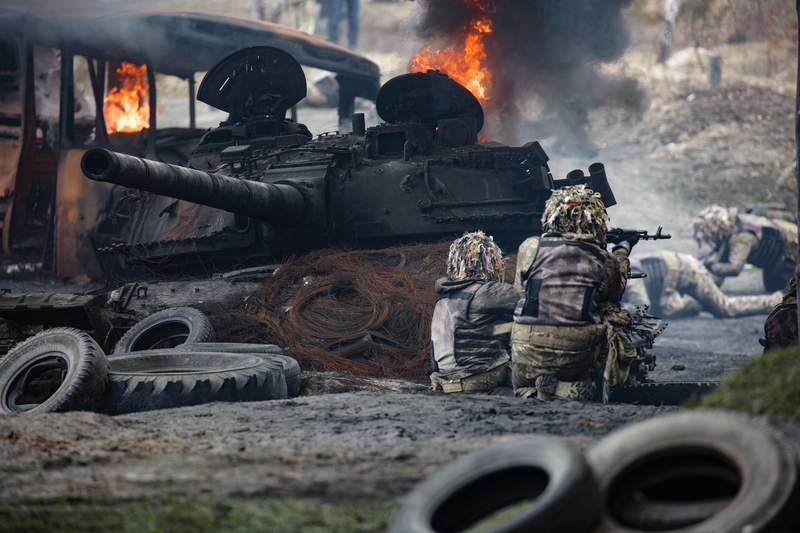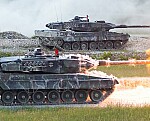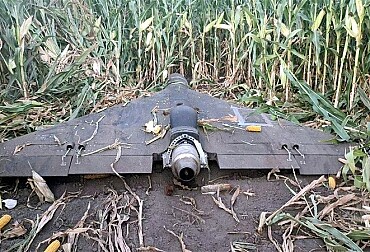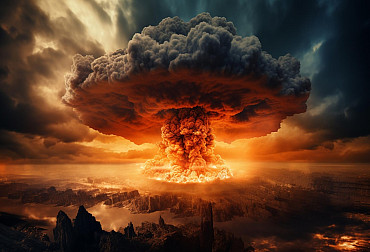General Jiří Šedivý: What to expect in the coming months in Ukraine
Former Chief of the General Staff of the Czech Armed Forces Jiří Šedivý provides a detailed analysis of the political-security environment that influences the shape of the West's assistance to Ukraine against Russian aggression, describes Ukraine's hesitation to mobilise, which may have fatal consequences, and warns of internal political divisions in the invaded country.

We are witnessing the number of conflicts increasing and the security situation not only in Europe, but around the world, becoming much more complicated. Our attention, which is focused primarily on Ukraine, has difficulty accepting that there may be a more significant conflict elsewhere than Europe with a greater potential for a large-scale conflagration. Since 7 October last year, we have been watching a growing conflict in the Middle East that is neither being stopped nor reduced in intensity. The involvement of Yemeni rebels in the conflict on the Hamas side has led to an almost complete halt to commercial shipping through the Suez Canal. The attacks on the US base in Jordan at the end of January resulted in the deaths of three US soldiers and led to the US decision to carry out strikes not only on Yemeni territory against Houthi bases, but also on Iraqi and Syrian territory, and possibly even Iran. The Israelis are failing, contrary to initial expectations, to resolve the destruction of the Hamas fighting wing quickly, creating a complicated situation not only in the Gaza Strip but also in Israel itself. The number of civilian casualties in the Gaza Strip is steadily increasing, yet the hostages being held have not been freed, and, despite some promising information, the time for a possible ceasefire and the beginning of a political solution to the crisis is not approaching. The United States' focus on the region is a distraction from the crisis in Ukraine, as is the never-ending wrangling between Democrats and Republicans in Congress over tightening immigration policy and unblocking military aid to Ukraine.
A number of top U.S. generals are also drawing attention to the growing dangers in the South China Sea and the Chinese president's increasingly aggressive statements about the historic obligation to reattach Taiwan to mainland China. At the same time, the increasing Chinese naval presence in the South China Sea raises the risk of direct US-China military conflict. There are several solid studies that anticipate such a confrontation within ten to twenty years. The urgency of the situation is underscored by the task Chinese President Xi Jinping gave to the Chinese armed forces in November 2022 to prepare for war. By 2027, China's military should be world-class to fully secure China's foreign interests.
Problems smoulder beneath the surface
Europe is in a situation where we are arguing about how to deal with the conflict in the Middle East, and where Europe is convulsed by demonstrations in support of Palestine, but especially in support of Hamas, which is a smoking gun next to a powder keg that may explode in the form of conflict in societies, especially in Western Europe. And it may be accompanied by another wave of terrorist attacks. The situation is probably more critical in Germany. But we see similar tendencies in Sweden, the Netherlands and, to a lesser extent, in other countries. It would suit the Russians if these potential crises were to flare up in a similar way to what happened in the Middle East last October. Although Germany is now the biggest supporter of Ukraine in Europe, its economy is struggling and its performance is declining. So are the other major economies: France and Italy. The UK is a lifeline, but cannot be expected (unless the US problem is resolved) to replace their capacity. Moreover, there is also a problem in the aid structure. Some of the weapons, equipment or munitions supplied by the US are not at all replaceable by European states.
There is also no unity in Europe that would allow quick and decisive decisions. Even Germany is not that stable politically, and behind the political statements one can sense fears about what will happen when the war is over and when the relationship with Russia should be restarted to allow at least some degree of cooperation. Germany is a pro-export economy and needs a large territory for the application of its own production. The loss of the Russian market is painful for Germany, not least because of the loss of cheap gas supplies.
The political representation in Poland has changed, but the Polish public is becoming increasingly sensitive to the various concessions that Ukraine is receiving. The protests by farmers and transport companies are certainly not the last dissenting voices from this community. Although Slovakia and Hungary are not the largest countries, the attitudes of the highest representatives are breaking European unity and pointing to tendencies that are not favourable to Ukraine. The statements made by the Slovak Prime Minister on Slovak radio on 27 January 2024 about Ukraine being 'not a sovereign state' and 'under the total influence of the USA', or that 'I will not support Ukraine's entry into NATO', are cautionary and indicate a shift in views on the conflict in Eastern Europe. Representatives of the far right in Hungary are already declaring that, in the event of the end of Ukrainian statehood, Hungary would claim the annexation of Transcarpathia. Similar voices have been heard from Romania.
In this environment, the prelude to Russia's spring offensive in Ukraine is unfolding. Not everything is black and white and not everything the Ukrainians have done is wrong. It is also our fault. As recently as September, most security analysts believed in a Ukrainian victory; today, the same analysts condemn Ukraine. The Ukrainians are improving military technology, or have learned to handle modern technology quite well. They are increasingly able to replace undelivered weapons and equipment. Trying to transfer arms production to Ukrainian territory may seem like a difficult task, but it can make up for some of the shortfalls in supplies from Europe. In any case, focusing on the accelerated introduction of NATO standards into the Ukrainian military and concentrating on modern technology can help address the pressing problem of declining Western support. It may not fully replace the required long-range weapons, but the recent Ukrainian strikes deep into Russian territory (up to 1,200 km) give hope for a change in the situation and put pressure on the Russian logistical supply chain, not to mention depleting Russia's overall ability to support its troops in Ukraine. In addition, it has an impact on Russian society, which is feeling the direct effects of the war.
It is the right tactic, but it has limitations. First of all, it is limited by Ukraine's capabilities and its ability to produce more resources. It is clear from the current rapid developments that this would not be possible without the help of Western experts.
So in what environment is Ukraine approaching a decisive battle? Beyond the above, there are too many signals that the situation is not going well for Ukraine. First of all, the relentless political promises and declarations of political support from European allies are not being met with material support at a sufficient speed. Thus, the 'rationing' of ammunition and other necessary military material to Ukrainian soldiers is being reduced. Unfortunately, we have not yet seen the fabled F 16 aircraft, which should have been on the battlefield long ago. The training of pilots is complicated and rather long. Firstly, there were endless political negotiations about whether Ukraine would receive the F 16 at all, and because of this, the training of pilots and technical staff started late. Their deployment into combat has still not taken place. One of the problems is that the Ukrainians have focused on the 'wonder weapon' in successive waves, only to discover later that it has not lived up to their expectations. This is the case with MiG-29s, Leopard tanks, 155 mm howitzers, Western rocket launchers (representative of HIMARS), Bayraktar UAVs, etc. The systemic solution is clearly lagging behind the reality, which deepens the deficit of our support.
The deepening split in the Ukrainian leadership
Crucially, however, there has been a deepening split in the very top leadership of Ukraine for several months. It is certainly being exaggerated by Russian propaganda, but firstly, the inconsistency in assessing the outcome of the counter-offensive and, these days, the inability to decide and move forward in the event of a necessary mobilisation show the seriousness of the situation. (The article was written on 30 January 2024, at a time when the Russians are consolidating their positions on the Kharkiv direction, having managed to take control of Marinka and are fighting for the town of Donetsk.) The discussion of who actually needs the mobilization of up to 500,000 troops, whether the president (V. Zelensky) or the commander of the armed forces (G. Zaluzhny) is absolutely unnecessary and complicates the launch of the mobilization. To date, the Ukrainian Parliament has not received a corrected version of the law on mobilisation after its return, or has not yet decided on it. The replenishment of the Ukrainian troops is a cruel task, which in effect will determine success or defeat in the expected spring fighting.
The complicated situation on the front and the problems of mobilisation
The Russians are succeeding step by step in preparing the spring offensive and depleting the Ukrainian troops. This is a systematic activity that is tiring for both sides, but the Russian one is subsidized by the huge reserve of forces and resources at Russia's disposal. In positional warfare, the most advanced weaponry does not always play a vital role. An example is the Russians' use of a reasonably modernized tank, which becomes an effective enough weapon to fulfill its role in large numbers. This is, for example, the debate about the T-55 and T-62 tanks that were transferred in May 2022. The static phase of the fighting allowed these tanks to bury themselves in firing positions and protect them against strikes from the upper hemisphere. Although most of the tanks were certainly destroyed, they fulfilled their role. Ridicule of such tanks was not entirely justified. The photographs showed tanks with the Volna fire control system mounted. We know this system from the time when it was a direct competitor of the Czechoslovak Kladivo system, and its qualities were tested in the first half of the 1980s in the Boletice military area in the so-called comparative tests. To the benefit of our researchers, it can be stated with certainty that the Kladivo won the "competition", but it should also be noted that in terms of range and accuracy it was a system that significantly improved the combat value of the old T-54/55 and T-62 tanks. Compared to the Leopard tanks delivered, it is a relatively effective weapon.
The need to replace soldiers at the front with new but trained soldiers is repeatedly stated in the testimonies of Ukrainian soldiers at the front. (The average age of Ukrainian soldiers at the front of 52 to 54 years is alarming). The emphasis is on the word "trained". But even if the Ukrainian parliament decides to mobilize today, it is almost too late. Time is inexorable and the process of calling up the reserves, assigning them to units, equipping and arming them, followed by either basic or advanced training and training with equipment must be completed by the alignment of units and formations, both all-military and specialist. This is not a matter of one month.
Sending untrained soldiers to the front will mean a large number of casualties that may result in defeat or the loss of additional Ukrainian territory. In this winter period, the Russians are increasing their combat activities, aware of the mentioned Ukrainian weaknesses. Through tactical combat operations, they are improving their positions and preparing for a major spring offensive. They are aided in many of their successes by the above-mentioned problems of the Ukrainian army. What plays in Ukraine's favor is that the Russians continue to suffer from a lack of a quality command corps. Despite some improvement, there is still evidence of superficiality, sloppiness and disinterest in the common soldier. Naturally, this is also shown by the tactics of fighting: repeated attacks with little or no hope of success and little hope that the common soldiers will survive a poorly prepared attack. Criticism of a superior is not forgiven. The fate of General Popov, commander of the 58th Army, shows how a soldier, even a high-ranking commander, can end up if he complains. Despite the heavy losses, Russia is making slow but steady progress these days in preparing an offensive.
Is there a real fear of further Russian aggression against Europe?
Recently, many politicians and soldiers alike have warned of further Russian aggression. Allegedly, we can expect a Russian attack as early as 2025. I dare say that this is far-fetched. These scenarios overlook a number of logical facts. For example, the state of the Russian army today and the fact that it is still unable to decisively overcome the Ukrainian defences. The Russian economy may not have collapsed under sanctions, but it is undoubtedly suffering. This is also due to the fact that it has gradually reoriented itself in the defence industry and downstream industries towards war production. Hundreds of thousands of men have left the economy to go to war, tens of thousands will not return, and tens of thousands more are and will be scarred by war physically or psychologically. The only way another Russian attack could happen is if NATO disintegrates or if Article 5 of the Washington Treaty is not invoked. Into this scenario would have to be inserted the fact that the US would not join in the defence of Europe. (In the meantime, we should take former President Trump's statements about the future US relationship with NATO with a grain of salt.) Even so, Europe would have sufficient forces to defend itself against Russia. Logically, on the condition that we pay adequate attention to our defences. But such statements, without proper comment, can have the opposite effect. If Russia does not mobilise this year (reportedly as early as February) to prepare for war with NATO, and if nothing happens in 2025, the attention of politicians and the populations of Western states may be diverted from defence matters and Europe will once again fall into lethargy, which would be the very moment Russia has been waiting for.
That is why those in charge should think carefully about what is released to the media and how certain information is presented. In general, NATO has been preparing for such a situation since its foundation, and therefore such scenarios have always existed. Despite the seriousness of today's reality, it is important to remember that there are limits to exaggerating a possible conflict with Russia in the form of a massive military attack. That is our preparedness and the enormous potential, including the military potential that NATO has. We should therefore be able to improve our defensive rampart in the east with a calm head and not create a psychosis which, as a result, may divert attention from helping Ukraine.

Ukraine, and we with it, are at a critical point in the war when any mistakes by us and the Ukrainians may become the reason for total failure. It is often already almost too late, but many things can be corrected. If the divisions at the highest levels of the Ukrainian leadership continue to deepen, the Ukrainians will lose their 'compass' and their confidence that together they are able to resist Russian aggression. For the third time in a short time, I quote the greatest strategist on whom our art of war is based, Master Sun, from his Book of Sophisticated Attack: "The general rules of warfare: the main thing is to preserve the unity of one's own state, and the second is to disperse the foreign army"...








